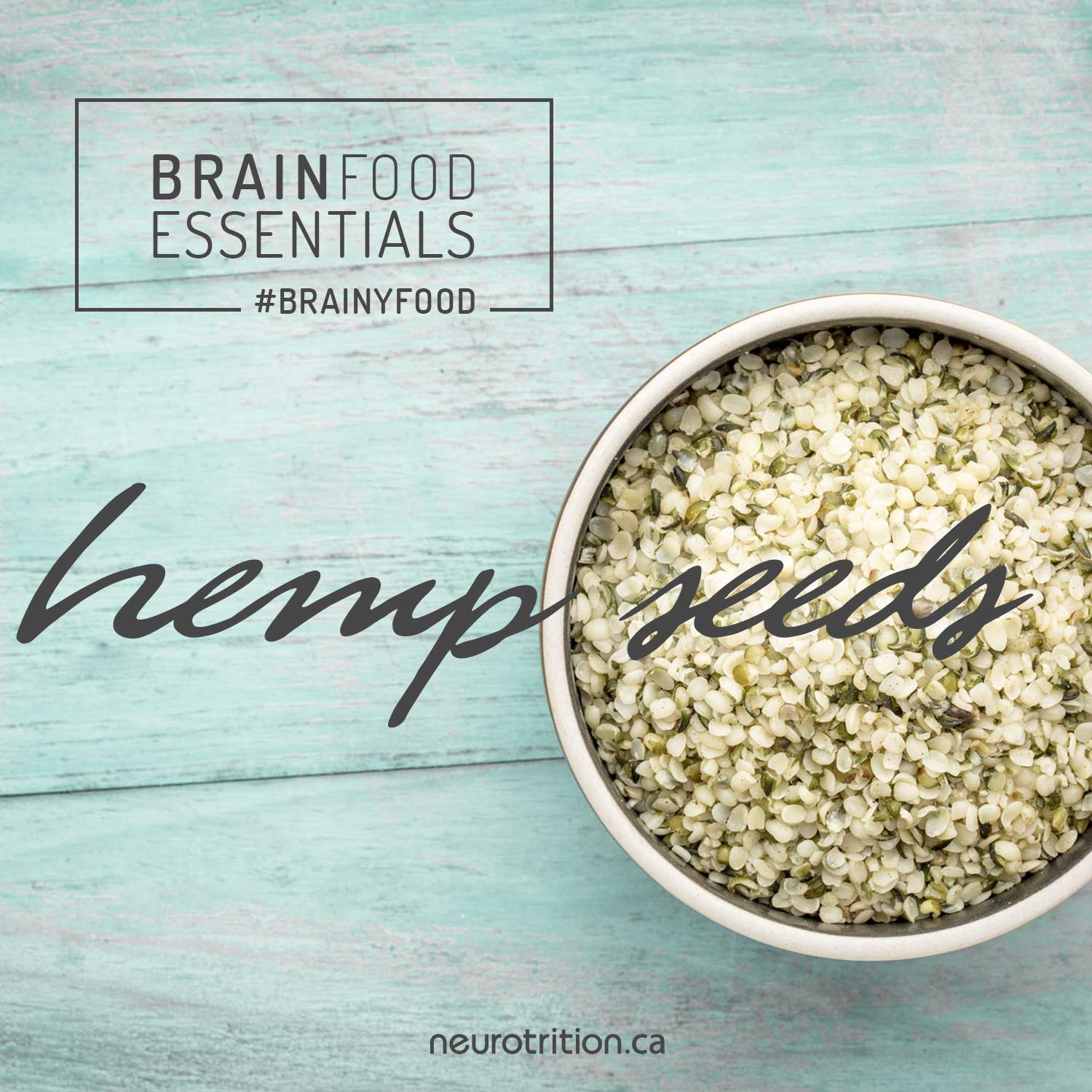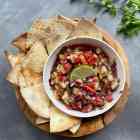Brain Food Essentials: Hemp Seeds

Guess which brain food is a favourite of our NeuroTeam?
Yup! It’s the humble hemp seed. Hemp seeds are brain food.
We’re not talking about psychoactive cannabis, a.k.a. marijuana, here (more on that in a future post). Yes, cannabis and hemp seeds come from the same species of plant. But industrial hemp seeds, the food, contain almost no THC (the psychoactive substance in cannabis). And as you can imagine, if we’re calling it a “brain food essential” it's super-nutritious. And absolutely delicious.
SMALL BUT MIGHTY
Hemp seeds are one of the best plant-sources of protein. They also contain brain-friendly antioxidants and omega fats. Not to mention vitamin E, minerals, and special fibre (called resistant starch) that is prebiotic and your gut bugs just looooove.
Hemp seeds are one of the best plant-sources of protein. They also contain brain-friendly antioxidants and omega fats.
In a nutshell (seed shell?), these tiny seeds are packed with brain nutrition.
They make a great dairy-free milk, and are a delicious topping for yogurt, buddha bowls, and salads. You can even buy hemp-based protein powders.
If there are two macro-nutrients that really stand out in hemp seeds, they are: protein and fat. So, before we get into some of our recipes that you can take to the next level with hemp seeds, let’s go over the brainy benefits of these two key players.
HEMP SEED PROTEIN
Protein isn’t only for your muscles, it’s critical for brain development and neurotransmitter function. Neurotransmitters are the biochemical messengers that help our nerve cells communicate. And they’re super-important for optimal brain function and mental health.
In fact, our Science Council member, Dr. Teresa Reyes studies the link between diet and brain function (our fav topic).
One of her areas of focus is on how important protein is for pregnant moms to ensure optimal brain development of their babies. Insufficient protein during pregnancy is linked with behavioural issues. It can also affect how the brain responds to the neurotransmitter dopamine that is associated with motivation and drive.
So as you can see, protein is important for your brain! But what about hemp protein makes it special?
Hemp seeds contain around 25% protein, which is substantial. The protein in hemp seeds is very high quality because it contains “nutritionally significant” amounts of all essential amino acids.
Hemp seeds contain around 25% protein, which is substantial. Also, the protein in hemp seeds is very high quality because it contains “nutritionally significant” amounts of all essential amino acids.
Amino acids are the building blocks of protein. Some amino acids are considered “essential” because our bodies cannot make them and we must get them from our food. While all plant foods contain amino acids, hemp seeds are one of the few plants that contain significant amounts of ALL the essential amino acids your body needs. This is something that very few plants can brag about!
And, while we don’t typically like to brag, we’re proud to brag about hemp seeds!
HEMP SEED FATS
Just like with proteins, there are certain "essential” fats that your body can’t make and you need from food. Hemp seeds contain these essential fats, omega-3 and omega-6, which are crucial for optimal health.
Omega-6? (You might be asking, as the information out there about omega-6s can seem conflicting.)
Yes, omega-6. It’s all about the RATIO.
You need both omega-3s and omega-6s. But a typical “Western” diet contains too many omega-6 fats. This throws off the body’s balance (the ratio) between the omega-6s and omega-3s. And this is exactly why we recommend eating more omega-3 fats...
You need both omega-3s and omega-6s. But a typical “Western” diet contains too many omega-6 fats. This throws off the body’s balance (the ratio) between the omega-6s and omega-3s. And this is exactly why we recommend eating more omega-3 fats (and barely mention omega-6s) and suggest taking an omega-3 supplement. In fact, research shows that for mental health issues like depression and anxiety, it’s the omega-3 EPA that seems to be most important.
But, hemp seed fats are special! They contain the optimal ratio of omega-6 to omega-3s, which is 2:1.
In fact, healthy fats like these are key for reducing inflammation, and improving heart health. And heart health is linked with brain health!
You might say that hemp has the perfect balance of fats, which is another reason why we love hemp seeds as brain food.
5 EASY WAYS TO EAT AND DRINK HEMP SEEDS
Now that you’re “in the know” about the mighty hemp seed’s benefits, how can you eat and drink more of them?
I can only begin to tell you how versatile these seeds are.
1. You can make homemade hemp milk as easily as almond milk. Add 1/2 cup hemp seeds and 2 cups of water into your high-powered blender and blend until smooth. Then you can strain it through a nut milk bag to get rid of the pulp. Easy peasy.
There are a few things you can do to boost this hemp milk:
- Add a couple of pitted Medjool dates before blending the hemp milk;
- Add 1/2 tsp pure vanilla extract, 2 tsp raw honey/pure maple syrup, and a dash of sea salt; or,
- Make it even brainier (and more decadent) by adding in 2 tbsp of raw cacao powder to ramp up those antioxidants, minerals, and fibre; or,
- Add 1/2 cup of berries and enjoy a super-healthy version of your childhood favourite (unless I’m the only one who loooved it) strawberry milk.
2. Try subbing hemp milk for the almond milk in our dairy-free coffee creamer recipe HERE. Or our brain-boosting hot cocoa recipe HERE.
3. You can throw hemp seeds in your favourite smoothie. Hey, have you tried our newest one? It’s a blueberry basil smoothie. It’s even hypoallergenic!
4. Hemp seeds are also a great topping for a bunch of dishes! Try them on:
- Yogurt (NeuroT Rx: We recommend plain Greek yogurt, organic when possible);
- Buddha bowls (picture a big bowl with rice/quinoa, greens, veggies, and drizzled with dressing);
- Salads, like our Cinco De Mayo Brown Rice Salad, or our Better Slaw.
5. What about hemp seeds in a creamy salad dressing? Try this Citrusy Hemp one. Simply blend up 1/4 cup orange juice, 1/4 cup lemon juice, 1 tbsp extra virgin olive oil, 1 clove garlic, 3 tbsp hemp seeds, and salt and pepper to taste. Drizzle some of that on your buddha bowls and salads. It’s delicious!
So, if hemp seeds are not already part of your regular diet, try including them. Not only for their solid nutrition, but because they’re a delicious seed that takes any dish up a notch. They are 100% approved by our NeuroTeam! Trust us!
- References
-
- Callaway, J.C. (2004). Hemp seed as a nutritional resource: an overview. Euphytica 140, 65–72. 10.1007/s10681-004-4811-6
- Chen, T., He, J., Zhang, J., Li, X., Zhang, H., Hao, J. & Li, L. (2012). The isolation and identification of two compounds with predominant radical scavenging activity in hempseed (seed of Cannabis sativa L.). Food Chem. 2012 Sep 15;134(2):1030-7. doi: 10.1016/j.foodchem.2012.03.009.
- Gómez Candela, C., Bermejo López, L.M. & Loria Kohen, V. (2011). Importance of a balanced omega 6/omega 3 ratio for the maintenance of health: nutritional recommendations. Nutr. Hosp. 26, 323–329. 10.1590/S0212-16112011000200013
- House, J.D., Neufeld, J. & Leson, G. (2010). Evaluating the quality of protein from hemp seed (Cannabis sativa L.) products through the use of the protein digestibility-corrected amino acid score method. J Agric Food Chem. 58(22):11801-7. doi: 10.1021/jf102636b.
- Lesma, G., Consonni, R., Gambaro, V., Remuzzi, C., Roda, G., Silvani, A., Vece, V. & Visconti, G.L. (2014). Cannabinoid-free Cannabis sativa L. grown in the Po valley: evaluation of fatty acid profile, antioxidant capacity and metabolic content. Nat Prod Res. 28(21):1801-7. doi: 10.1080/14786419.2014.926354.
- Radočaj, O., Dimić, E. & Tsao, R. (2014). Effects of hemp (Cannabis sativa L.) seed oil press-cake and decaffeinated green tea leaves (Camellia sinensis) on functional characteristics of gluten-free crackers. J Food Sci. 79(3):C318-25. doi: 10.1111/1750-3841.12370.
- Rodriguez-Leyva D. & Pierce N. G. (2010). The cardiac and haemostatic effects of dietary hemp seed. Nutrit. Metabol. 7:32 10.1186/1743-7075-7-32
- Vonapartis, E., Aubin, M.P., Seguin, P., Mustafa, A. F. & Charron, J.B. (2015). Seed composition of ten industrial hemp cultivars approved for production in Canada. J. Food Comp. Anal. 39, 8–12. 10.1016/j.jfca.2014.11.004
- Vucetic, Z., Totoki, K., Schoch, H., Whitaker, K.W., Hill-Smith, T., Lucki, I. & Reyes, T.M. (2010). Early life protein restriction alters dopamine circuitry. Neuroscience, 168(2),359-370.
- Yan, X., Tang, J., dos Santos Passos, C., Nurisso, A., Simões-Pires, C.A., Ji, M., Lou, H. & Fan, P. (2015). Characterization of Lignanamides from Hemp (Cannabis sativa L.) Seed and Their Antioxidant and Acetylcholinesterase Inhibitory Activities. J Agric Food Chem. 63(49):10611-9. doi: 10.1021/acs.jafc.5b05282.










